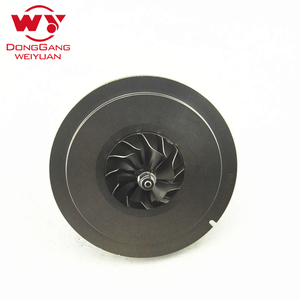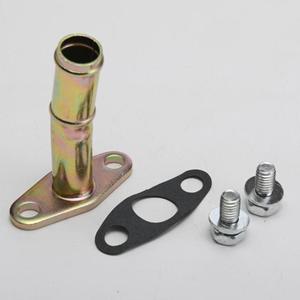(554 products available)





















































































































































































The K16 turbocharger is a small turbocharger used for light-duty diesel engines and high-performance gasoline engines. The K16 turbo is a variant of the K-series turbochargers. K16 turbochargers are manufactured by various aftermarket auto part brands. The K16 turbocharger is available in different types, depending on the make. Here are some of the most common types of K16 turbochargers:
Single K16 Turbocharger
A single K16 turbocharger is installed on a single exhaust system. The K16 single turbo is sought after because of its ability to enhance engine performance. The K16 single turbo takes in exhaust gases from the engine, which spins the turbine blades. The turbine blades spin the compressor blades, sucking in air and forcing it into the engine's combustion chamber. By compressing the air, the K16 single turbo increases the engine's horsepower. The K16 single turbo is ideal for light-duty diesel engines and gasoline-powered vehicles.
Twin K16 Turbochargers
Some vehicles come with twin K16 turbochargers, with one turbocharger assigned to each bank of cylinders. The twin K16 turbochargers allow for more balanced power delivery. The K16 twin turbochargers spool up quickly, generating boost pressure at lower engine speeds. This reduces turbo lag and makes the vehicle more responsive. The K16 twin turbochargers are suitable for high-performance engines, heavy-duty diesel engines, and large-volume naturally aspirated engines.
Variable Geometry K16 Turbocharger
Variable Geometry K16 turbocharger features adjustable blades in the turbine and compressor sections. The adjustable blades increase or decrease the amount of exhaust airflow that hits the turbine. This allows for optimal boost pressure across the entire engine's RPM range. The variable geometry K16 turbocharger eliminates turbo lag and improves engine efficiency and emissions. Variable Geometry K16 turbochargers are suitable for high-performance engines, heavy-duty diesel applications, and vehicles that demand consistent power delivery.
Regular Oil Changes
Fresh oil cleans the engine and turbochargers. It prevents dirt buildup that could clog the K16 turbocharger and cause it to malfunction. Regular oil changes also ensure proper oil flow through the system. This lubricates all the moving parts. The oil reduces friction and heat generation. This protects the K16 turbocharger from damage. The K16 turbocharger lasts longer with consistent lubrication from fresh oil.
Cool-Down Periods
When driving at high speeds, the K16 turbocharger works hard. The exhaust it generates is very hot. Stopping the vehicle suddenly does not allow the turbo to cool gradually. This is because the engine continues to run. The heat from the exhaust can damage the turbo parts if they are not cooled properly before turning off the ignition. Taking a few minutes to drive slowly or idle allows the turbo to lower the temperature gradually. This protects the K16 turbocharger from heat-related issues over time.
Inspecting and Replacing the Air Filter
The air filter prevents dirt from entering the engine and turbo system. A clogged filter restricts airflow. This forces the K16 turbocharger to work harder. It strains the component and causes it to wear out faster. Regularly checking the air filter is important. It should be replaced every 15,000 miles or as needed. A fresh filter keeps airflow smooth. The K16 turbocharger runs optimally without excess stress.
Using Quality Lubricants
Quality oils and fluids meet the specifications set by the K16 turbocharger manufacturer. They ensure proper lubrication is provided throughout the system. The oils reduce friction between moving parts. This protects components like the turbo itself from premature damage. Using non-recommended fluids can cause issues over time. The wrong viscosity may not flow correctly or provide adequate lubrication.
Regular coolant changes
Like oil, coolant requires periodic changes to maintain effectiveness. Over time, additives in the coolant break down. This may lead to corrosion in the cooling passages of the K16 turbocharger. Regular changes ensure optimal heat transfer. The K16 turbocharger stays at the right temperature with fresh coolant. This protects it from heat-related damage.
Pre-lubrication
Before starting the engine, the K16 turbocharger should be pre-lubricated. This ensures oil circulates to all moving parts. It only takes a few seconds. Pre-lubrication helps avoid dry starts. A dry start occurs when the turbo is cranked without oil first. The lack of lubrication can cause excessive wear on the K16 turbocharger's bearings and other components over time. Taking a moment to pre-lubricate protects the turbo from damage.
Regular Exhaust System Inspections
The health of the exhaust system is crucial for proper turbo function. Regular inspections ensure there are no leaks or blockages. A damaged exhaust can impact how the K16 turbocharger performs. For instance, a crack may allow exhaust gases to escape prematurely. This affects the turbo's ability to boost engine power effectively. Blockages also disrupt the flow needed for optimal operation.
Monitoring Boost Pressure
Boost pressure is an indicator of the K16 turbocharger's health. Using a boost gauge, owners can monitor levels while driving. If the gauge shows lower than normal pressure, it signals a potential issue with the turbo. There could be wear affecting how it forces air into the engine. Too high boost pressure can also point to problems. For instance, a wastegate malfunctioning means more work for the turbo.
Checking Wastegate Operation
The wastegate regulates boost levels. An improperly functioning wastegate can strain the K16 turbocharger. It's important to visually inspect this component as specified by the manufacturer. The linkage should move smoothly without sticking. There are also periodic tests the driver needs to conduct.
Scheduled Timing Belt Changes
While the timing belt is tied to engine operation, its condition impacts the K16 turbocharger as well. A worn timing belt can cause the engine to run unevenly. This puts additional stress on the turbo to keep up with fluctuations in power demand. Replacing the timing belt at regular intervals helps prevent this. It ensures the engine runs smoothly, so the K16 turbo doesn't have to work harder than necessary.
Regular Professional Inspections
Even with at-home maintenance, it's wise to have the K16 turbocharger and entire forced induction system checked out by a pro mechanic periodically. Pros have the tools and expertise to thoroughly assess turbo health. They can catch minor issues before they become major problems through diagnostic testing and component evaluations.
Choosing the right K16 turbo for a vehicle requires careful consideration of several factors to ensure compatibility, performance, and reliability. Here are some tips to help choose the right K16 turbocharger:
Replacing a turbocharger is not a simple task that just anyone can do. It requires someone with experience and advanced mechanical knowledge. Below are some of the requirements that need to be fulfilled before replacing the turbocharger:
Below is a step-by-step guide for replacing the turbocharger:
Q1: What is a K16 turbo?
A1: The K16 turbo is a turbocharger that is used in high-performance vehicles. The K16 turbo generates a large amount of airflow and is used to upgrade the stock turbochargers.
Q2: Can the K16 turbo be fitted into any vehicle?
A2: The K16 turbo can only be fitted into vehicles designed to accommodate turbochargers. However, modifications can be done to other car models to enable fitting of the K16 turbocharger.
Q3: How long do K16 turbochargers last?
A3: K16 turbochargers can last for about 150,000 to 200,000 miles with proper maintenance. Factors such as high operating temperatures, poor lubrication, and wear and tear reduce the lifespan of K16 turbochargers.